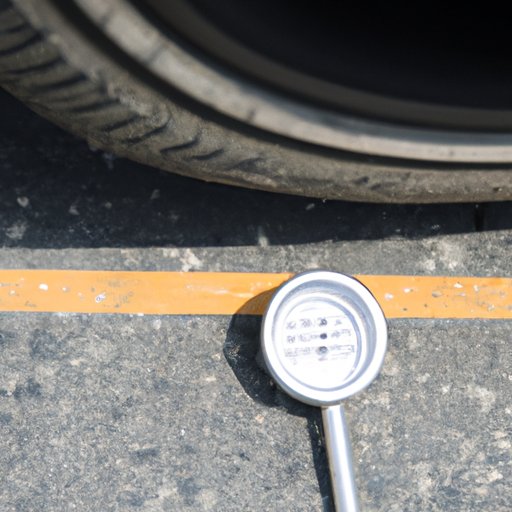Introduction
Tire Pressure Monitoring System, commonly abbreviated as TPMS, is an electronic system that monitors changes in the air pressure of tires on various types of vehicles. Whether you’re driving a car, a truck, or a bus, TPMS can alert you to underinflated tires to help prevent accidents, improve fuel efficiency, and prolong the life of your tires. The purpose of this article is to provide a comprehensive guide to TPMS. We will explore its benefits and importance, how it works, how to maintain it, and how it can help you stay safe on the road.
The Ins and Outs of TPMS: A Comprehensive Guide to Tire Pressure Monitoring Systems
The TPMS system consists of a set of sensors that are installed in each tire. These sensors monitor the air pressure in the tires and transmit data to the car’s computer system. When a tire’s air pressure drops below a certain threshold, the system will alert the driver with a warning light or message on the dashboard. This allows the driver to take prompt action to inflate the tire or have it repaired or replaced.
The importance of TPMS in ensuring vehicle safety cannot be overstated. When a tire is underinflated, it can overheat and wear out more quickly. It can also negatively impact vehicle handling and braking, increasing the risk of accidents. The use of TPMS can help drivers avoid these problems, reducing the risk to both drivers and passengers.
To get the most out of your TPMS, it’s important to maintain it properly. Regularly check your tire pressure, inspect your tires for signs of wear, and replace damaged sensors. This will help ensure your TPMS stays accurate and continues to provide essential information to keep you safe on the road.
Why TPMS is Critical to Your Safety on the Road
TPMS can help prevent tire blowouts, which can be dangerous and costly. In addition, TPMS helps drivers maintain better control of their vehicles, especially in adverse conditions such as rain, snow, and ice. It can also reduce the risk of hydroplaning, which can occur when tires lose contact with the road surface due to a buildup of water.
Since the introduction of TPMS, vehicles equipped with this technology have experienced a reduction in tire-related accidents. Thus, TPMS is an effective tool in preventing accidents, minimizing the severity of injuries, and saving lives.
TPMS vs. Traditional Tire Pressure Monitoring: What’s the Difference and Why Does it Matter?
Prior to the development of TPMS, tire pressure was usually checked using a tire gauge. This method of checking tire pressure is often inaccurate and depends on the driver recognizing when the pressure is low, and paying attention to underinflated tires. TPMS is more accurate and reliable, as it provides continuous monitoring and immediate alerts.
In addition to its accuracy, TPMS offers several other advantages. It can help drivers save money on fuel costs by ensuring optimal tire pressure, reducing the risk of tire blowouts, and prolonging the life of the tires. TPMS is also becoming more common in modern cars, making it easier for drivers to access and benefit from this tool.
The Cost of Neglecting Your TPMS: How Skipping Routine Maintenance Can Hurt Your Wallet and Your Safety
Ignoring TPMS maintenance can have serious consequences. Driving on underinflated tires can cause increased fuel consumption, premature and uneven tire wear, and increased risk of accidents. It can also lead to fines and penalties, as some states require vehicles to have functioning TPMS systems. By not taking care of your TPMS, you can be putting yourself at risk of costly repairs, or even endangering yourself and others on the road.
TPMS Myths: Debunking Misconceptions About Your Tire Pressure Monitoring System
There are several common misconceptions about TPMS that can lead to confusion and misinformation. One of the most common is that TPMS is not necessary, or that it is inaccurate. Both of these beliefs are false. The truth is, TPMS is an essential tool for vehicle safety, and its accuracy has been tested and proven over many years of use. Another myth is that TPMS only alerts drivers to low air pressure. In fact, some TPMS systems use sophisticated technology to monitor other factors, such as temperature and tire rotation, to provide even more accurate data to drivers.
Conclusion
TPMS is an important tool for maintaining vehicle safety and prolonging the life of your tires. By properly maintaining your TPMS system, you can avoid costly repairs, reduce the risk of accidents, and save money on fuel costs. Remember to regularly check your tire pressure, inspect your tires for damage, and replace damaged sensors. By using TPMS as a tool for safety, you can ensure that your vehicle runs more smoothly and safely, for both you and your passengers.
